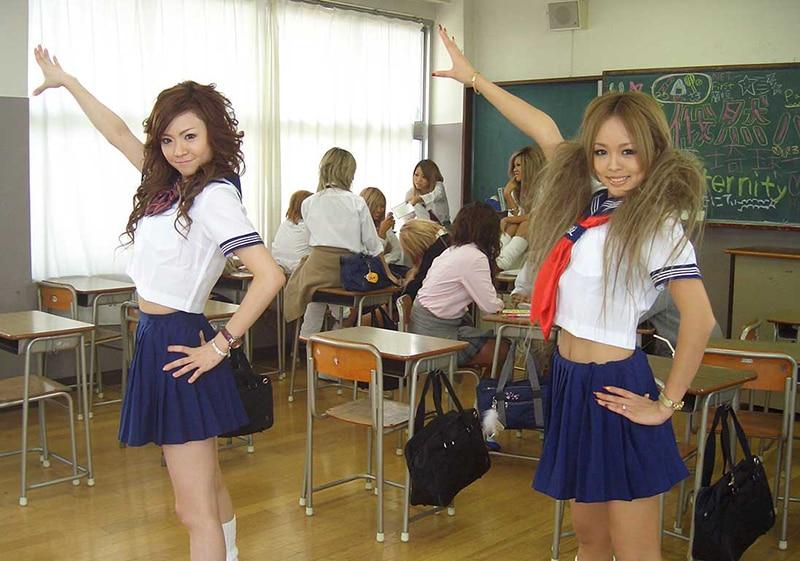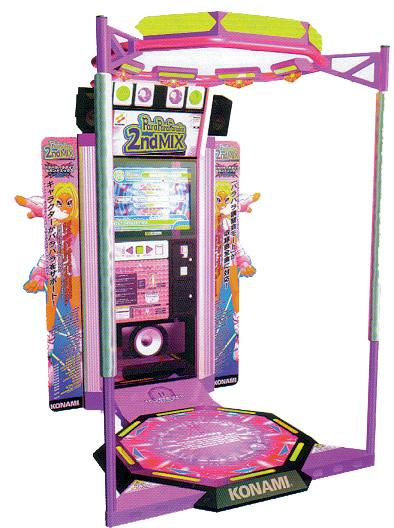
Eurobeat and Para Para Dance: An Italian-Japanese Relationship
In recent decades, increased globalization has led to an increased exchange of cultural artifacts, including music and dance. In this paper I will describe the relationship between Para Para Dance, a Japanese dance style, and Eurobeat, a music style produced in Italy.
Eurobeat
Eurobeat is a high speed (between 150 - 160 BPM) and bouncy European music genre "in which high quality technology [gives] the music a sheen that assure[s] club and radio play" (Laitin, 2002). One of the main elements is the use of synthesizers, but without losing focus on the singer's voice. It was created in the 80s, alongside other emerging "Euro-genres" that were being developed and mingled at that time, such as Europop and Eurodisco.
Like most European countries, Italy and Germany were creating their own local versions of these genres, and succeeded in establishing their place in the Disco scene. Eurobeat originated from German and Italian disco influences (Laitin, 2002). This genre stood out in nightclubs, especially gay clubs, and replaced the "high energy" of Eurodance (Frith, 1989). Dave Rodgers, Niko, Domino and Lolita are some of the most well-known Eurobeat artists.
Interestingly, despite its German and Italian origins, and its primarily German and Italian producers, most Eurobeat songs have English lyrics. The use of English in Eurobeat songs can be explained by the ‘Americanisation of youth culture’ worldwide in the 60s and 70s and the recognition of the US market as a guarantee of success for artists. Even in the 80s English-lyric songs reached the top charts in Europe (Laitin, 2002).
This music genre was directly responsible for the creation of a Japanese dance style, the Para Para Dance, in the 80s. Eurobeat's Japanese consumer market originated with the Japanese independent music label Avex. In the 80s, Avex's future founder Masato Matsuura was a record rental shop owner. Always on the lookout for trends, he found a new niche for his business: Eurobeat song compilations. For a while he got away with publishing the unliscensed compilations, but protests from artists and labels forced him to obtain the proper permissions, eventually leading to the establishment of Avex as a record company (Arrieta, 2018).
In 1991, the company released the first CD of a series titled "Super Eurobeat." All the songs were produced in Italy but only sold in Japan due to copyright. In Japan, "at the discotheques (disuko) of the 1980s, urban youth danced to Eurobeat records being played at high volumes" (Kitagawa, 2009, p. 270). The first CDs of this series were produced in collaboration with some of the most popular nightclubs, since they already had the genre in their playlists.
Para Para dance (パラパラ ダンス)
ParaPara or Para Para is a dance style created in Japan that consists of sets of specific movements with repeated elements, danced to Eurobeat music. Each song has its own choreography routine, typically including much engagement of the arms and hands, fast and angular moves, and a back-and-forth foot movement.
The exact origin of Para Para is uncertain. One of the most cited versions is that it is derived from a movement called Takenoko-zoku (Baby Bamboo Tribe), popular in the latter half of the 70s: in the pedestrian zone of Harajuku, young people in vivid colorful costumes danced to disco music from radio cassette players (Nakao, 2015).
In 1985 the G5 nations (Japan, United States, Germany, United Kingdom and France) signed the Plaza Accord. This agreement aimed "to manipulate exchange rates by depreciating the U.S. dollar relative to the Japanese yen and the German Deutsche mark." The appreciation of the Japanese yen allowed Japan to become a major player in the international market through the early 90s. This period was called Japan's "bubble era", marked by higher purchasing power and extravagance. During this time, nightclubs became a symbol of luxury and many Japanese young people, like Takenoko-zoku dancers, started to frequent fancy nightclubs seeking fun.
"Around this time, European music came [to Japan] in under the name Eurobeat," and many nightclubs added this genre to their repertoire. Clubs like Maharaja Azabujyuuban and Eden Rock pioneered employing choreography teachers: at a certain point in the night, house dancers would emerge to teach club-goers new dances. It is speculated that these dancers created the first Para Para routines, however, "which clubs made certain routines during this era is largely unknown because it is not recorded." This era is known as the Para Para's first boom.
The second boom occurred in the early 90s. Even though many nightclubs went bankrupt due to economic bubble bursting, others continued to produce new routines, and even more club-goers learned them. Another boost to this dance style's popularity was the production of "Super Eurobeat" CDs and DVDs of Para Para routines by Avex.
Between 1999 and 2001, the J-Pop artist Takuya Kimura helped ignite the third boom by dancing the routine to Eurobeat classic "Night of Fire" on a television show. The Eurobeat remix of the "Mickey Mouse March", danced by Disney characters at Tokyo Disneyland, also attracted attention to Para Para Dance during this period. A further highlight of this period was the release of "ParaParaParadise" (PPP) by Konami Holding Corporation. It is an arcade game where the player "stays in a relatively fixed spot while moving their hands in choreographed movements [...] to specific songs and so activate infrared sensors in the correct sequences" (Smith, 2006).

Although there is a lot of controversy about the existence of a fourth boom, it is good to point out some additional milestones in Para Para Dance's history. In 2007, at the "Great Robot Exhibition" in Tokyo, the bipedal humanoid robot ASIMO, developed by Honda in 2000, showed some moves of Para Para Dance. For a Japanese audience, "the robot’s 1980s dance moves would certainly have been familiar and even heart-warming" (Sone, 2017).
More recently, due to the COVID-19 pandemic and subsequent lockdowns, the Avex and SuperEurobeat YouTube channels have begun uploading videos of Para Para routines. Recorded in the 90s and early 2000s, the videos now all have the same recommendation in the title and description: "おうちでパラパラ ♪ 親子でパラパラ!STAY HOME & PARAPARA", or "ParaPara at home ♪ ParaPara with parents and children! STAY HOME & PARAPARA." Since Avex owns the copyright to many Para Para videos, these YouTube releases can be considered a giant milestone. The videos have reached an impressive number of views and comments. Avex said in a statement that "there is a possibility that the reheat of Para Para will spread further."
Italy in Japan, Japan in Italy
The popularity of Eurobeat in Japan and the subsequent development of Para Para dance fits Tomlinson's (1999) concept of "mundane cultural experience," in which local routines are transformed by global influences.
Dance and music are often connected with each other. Both countries were actors in the transnational processes, i.e. those "not confined to the nation-state or to nationally institutionalized organizations" (Iwabushi, 2002, p. 16). This idea is supported by the notion of multidirectional flow and thus the cultural mixing recontextualizing the local (Iwabushi, 2002). As Japanese "discotheques'' were transformed by Eurobeat, Italian labels and producers were transformed by Japanese reception. This transformation can be understood in the sense of coexistence of Italian culture in the Japanese environment and vice versa. There is Italy in Japan and Japan in Italy.
This process of deterritorialization is not linear and does not mean "the end of locality, but its transformation into a more complex cultural space" (Tomlinson, 1999, p. 149). In other words, locations no longer have the power to determine cultural experiences by themselves. Experiences and spaces are impacted by countless influences. This complexity can be illustrated by the relationship between Italy and Japan and their transnational cultural products: Para Para Dance and Eurobeat.
J-Euro: The Hybrid
Since the Japanese dance style was created in reaction to Eurobeat songs, it might be expected that the Italian genre would dictate the next step for both art forms. This is not what happened. Similar to the progression of various Euro-genres to Eurobeat, Para Para dance movements were an evolution of Takenoko-zoku dance and an adaptation to a nightclub environment. Even though the songs used to create Japanese routines were from Italy, there was no predominance of one artistic practice or a specific country above the other. The relationship between Para Para Dance and Eurobeat, at first, was cooperative.
However, with the rise of trends like "Britpop'' (British music that emphasizes British culture - e.g., Oasis, Blur) in the mid-1990s and "Teen Pop" (pop music with focus on teen audiences) in the late 1990s (e.g., Spice Girls, Westlife), Eurobeat consumption in Europe radically decreased. In Japan, Para Para's third boom (1999 - 2001) helped maintain the genre. At the Japanese Gold Disc Awards in 2000, "Super Eurobeat Vol. 100" won the "Special Product Album of the Year" award.

With the decline of Eurobeat in Europe and the copyright to "Super Eurobeat" still owned by Avex, Italian labels and producers were forced to either change their styles, continue to produce Eurobeat songs for the waning European market, or develop their work for Japan.
Those labels that continued to produce for the Japanese market helped develop a hybrid form of music: "J-Euro". This "Japanese Eurobeat" is composed of 3 categories, all of which gained visibility with the Para Para scene in Japan: first are original Eurobeat songs covered in Japanese by Japanese artists, but still produced by Italian producers. Second are J-pop songs with Japanese lyrics and artists, but remixed in Eurobeat style by Italian producers. Third are Japanese Eurobeat songs from Japanese artists and producers.
It is difficult to determine whether there is a convergence of Japanese influence over Italian music production. In fact, some literature cited the term "Japanization" (Igarashi, 1997; Iwabushi, 2002), in comparison to the convergence process of "Americanization." However, this term only covers the consumption of cultural products made in Japan but not according to Japanese lifestyles or ideas (Iwabushi, 2002).
Additionally, Italian producers have not changed their production style. Even with the creation of J-Euro, Italian and Japanese producers kept the synthesizers, beats per minute, and the bouncy pattern. The addition of Japanese lyrics and cultural themes (e.g., animes, J-idols) just reinforces the hybrid nature of this new form of music.
According to Nederveen, hybridization as cultural mixing considers "asymmetry and unevenness in the process and the elements of mixing" (2009, p. 55). Taking into consideration Eurobeat's disappearing market on its home continent, it is possible to say there is an "assimilationist hybridity" (Nederveen, 2009). The market became Japan, centered on Japanese production and consumers. It is undeniable that there is a lot of Italian influence in J-Euro, directly and indirectly.
New cultural imaginaries
The case of Para Para Dance and Eurobeat has numerous intertwined layers revealing the complexity of global agents and dynamics. From a cultural perspective on globalization, it is an example of a shift in the convergent flows of appropriation and consumption. The codependence of both art forms represents a convergence of publics and the nations' openness to global crossings.
The concept of deterritorialization "grasps the way in which events outside of our immediate localities (...) are increasingly consequential for our experience. Modern culture is less determined by location because location is increasingly penetrated by 'distance'” (Tomlinson, 2003, p. 273). Hence, the bond between Japan and Italy through Para Para and Eurobeat can still be experienced through the maintenance of Eurobeat song production and "Eurobeat Nights" at Japanese nightclubs. The posting of Para Para routines to YouTube during the COVID-19 pandemic further promises to revitalize the dance and thus Eurobeat. This is the power of transnational cultural practices: once mixed and opened to transformations, it is possible for them to survive over the years, just waiting for their next opportunity.
Nederveen (2009) argues that structural hybridization and cultural hybridization are interdependent. So it is with Para Para and Eurobeat. Structural hybridization, referring to the "emergence of new practices of social cooperation and competition" (p. 89), is demonstrated by the production of European songs for the Japanese market and later the Japanese production of Eurobeat songs and compilations. Cultural hybridization, being "new translocal cultural expressions" (p. 89), is demonstrated by Para Para Dance and Eurobeat.
It may be difficult to imagine that a European music genre helped to originate a Japanese dance style. However, "new forms of cooperation require and evoke new cultural imaginaries" (Nederveen, 2009, p. 89).
References
Arrieta, N. M. (2018). AVEX: NUMBER ONE ON THE JAPANESE MUSIC INDUSTRY. In Haghirian, P., Business Development, Merger And Crisis Management Of International Firms In Japan: Featuring Case Studies From Fortune 500 Companies (pp. 161 - 178). Publisher World Scientific
Frith, S. (1989). Euro pop. Cultural Studies, 3(2), 166-172.
Igarashi, A. (1997). From Americanization to ‘‘Japanization’’ in East Asia? Journal of Pacific Asia, 4, 3–20.
Iwabuchi, K. (2002). Recentering Globalization: Popular Culture and Japanese Transnationalism. Duke University Press.
Kitagawa, J. (2009). Music culture. In Y. Sugimoto (Ed.), The Cambridge Companion to Modern Japanese Culture, pp. 261-280. Cambridge University Press.
Laitin, D. (2002). Culture and National Identity: 'The East' and European Integration. West European Politics, 25, 55-80.
Nakao, A. (2015). The formation and commodification of Harajuku’s image in Japan. Ritsumeikan Journal of Asia Pacific Studies, 34.
Nederveen, P. J. (2009). Globalization and culture: Global mélange. Rowman & Littlefield.
Smith, J. (2006). Digital Dance Hall: The Fan Culture of Dance Simulation Arcade Games. In Grinter, R., Unger, A., & Macer, P.. Consuming Music Together Social And Collaborative Aspects Of Music Consumption Technologies Vol. 35, pp. 193 - 209. Springer.
Sone, Y. (2017). Japanese robot culture: performance, imagination, and modernity. Palgrave Macmillan.
Tomlinson, J. (1999) Globalization and Culture. University of Chicago Press
Tomlinson, J. (2003). Globalization and Cultural Identity. In D. Held (Ed.), The Global Transformations Reader: An Introduction to the Globalization Debate (pp. 269-277). Polity.